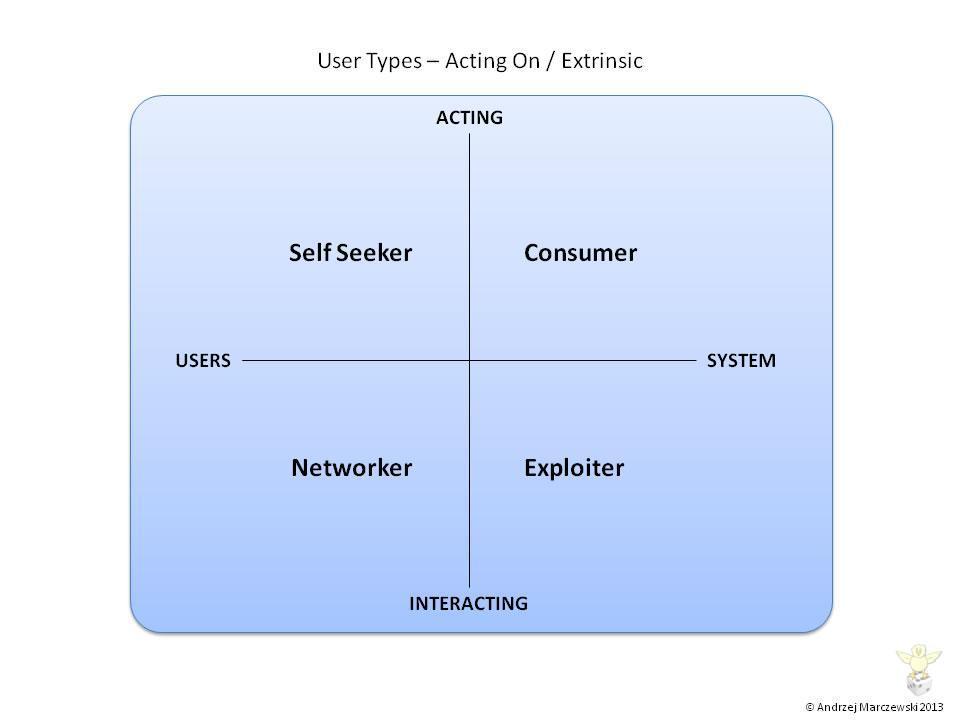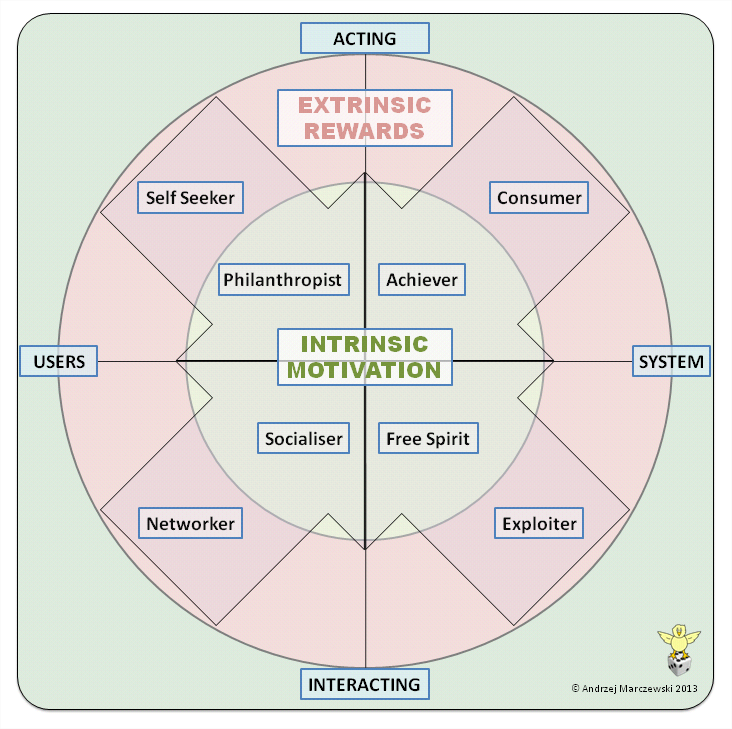Investigating the Bartle player types through intrinsic and extrinsic motivation
This is an Op-Ed by Andrzej Marczewski, an Intranet Web Manager at Capgemini UK and one of the top gamification evangelists. Andrezej earned this Op-Ed by being a Top Gamification Guru.
If you have an interest in gamification, the likelihood is that you have heard of something called Bartle’s Player Types. This is a model that Dr. Richard Bartle created to describe the types of people who played Multi User Dungeon (MUD) games, what they wanted, how they acted and how they interacted. Initially 4 types were identified; Killer, Achiever, Socialiser and Explorer.
Later, he would expand on this and create a more detailed model that included 8 types; Griefer, Networker, Politician, Friend, Opportunist, Scientist, Planner and Hacker.
This model is popular in gamification as it gives a nice basis to consider types of user you may come across. It is worth noting a few things though. The first, this is not a taxonomy, it is a dynamic model that not only explains initial types, but their interactions and evolution over time. The other important point is that this model was designed for MUD games (or MMO’s as we now see them). This takes a couple of things for granted – the biggest being that players are there to play! Dr Bartle is the first to admit that player types do not work all that well in gamification if you use them incorrectly. Consider a Killer type. This type is in a game to destroy and harm anything and everything – just because they can.
So with all of that in mind, I decided to take a stab at defining a few User Types you could expect to see in a gamified system. The starting point for me was to look at intrinsic motivation and the RAMP framework I described recently. This gave me 4 initial types; Socialiser, Free Spirit, Achiever and Philanthropist. Not a million miles away from Bartle’s types, but there are some important differences.
Intrinsically Motivated User Types
-
Socialisers are motivated by Relatedness. They want to interact with others and create social connections.
-
Free Spirits are motivated by Autonomy. They want to create and explore.
-
Achievers are motivated by Mastery. They are looking to learn new things and improve themselves. They want challenges to overcome.
-
Philanthropists are motivated by Purpose. This group are altruistic, wanting to give back to other people and enrich the lives of others in some way

I realized that there is a chunk of users missing from this, those that are in a gamified system for extrinsic rewards. Initially described as players, these are the users who are willing “play” your game. They will collect points and badges, seeking reward from the actions. The intrinsic user types have no interest in this; their reasons for being in a system are more personal.
Extrinsically Motivated User Types
This Player user type is more than just a single type, it is in reality a group in its own right. When designing a system for the intrinsic user types, you will need to consider things like players and also on-boarding. Using rewards is a valuable way to bring people into the system. How they act after they rewards have been exhausted depends on not just them, but how the system has been designed. With that in mind, I split the Player into 4 distinct types. These types act in a similar way (for the most part) as the intrinsic types, except they are acting to get rewards.
The types are Networker, Exploiter, Consumer and Self Seeker. Now, these are all fairly emotive names, but they fit the actions well.
-
Networkers want to connect to others to increase their profile and the rewards that may bring, (think Klout style perk schemes).
-
Exploiters want to gain reward from using the system, possibly by any means. They will create things for the express reason of selling them, for example. They are also the ones who will find and use loopholes in the rules if it helps them gain rewards.
-
Consumers want rewards from their actions in the system. They will do quizzes, join loyalty schemes and learn but only if it gives them something in return.
-
Self Seekers want rewards for their actions with other users. For example, they will answer questions to get points, favouring quantity over quality.

What Now?
These eight types of user are by no means exclusive. Users are likely to display traits from multiple types. However, they give a solid foundation for designing experiences that are either heavily focused on a single type or can give multiple types something to engage with.
Lots of people have created their own taxonomies of player types. Amy Jo Kim has a very popular taxonomy for instance. The point is most, if not all, are designed to describe players in games. That may not be totally applicable to gamified systems.
Whichever types you decide to use, the main point is to understand that different things will engage different types of user.
If you want to create a great answers system (like Quora), there is no point focusing on creating a system that will attract Achievers or Consumers or Free Spirits. You are looking for Philanthropists, people who WANT to help others. Adding rewards systems to this may help on-board Self Seekers and the like, but will not create the kind of quality answers you are looking for long term. You have to plan on creating a system that favours the intrinsically motivated types.
If on the other hand, all you are looking for is people to hit a like button on a page, then you are probably going to want to attract consumers or exploiters, who will do activities just to get rewards.
This is an introduction to the User Types work I have been doing, for more take a look at my site under User Types. There is more to be done as this I by no means complete, but with luck it may help guide or focus your thinking! Also see Gabe Zichermann’s post on intrinsic and extrinsic motivation in gamification.









Hi Andrzej,
I agree when you say “different things will engage different types of user”, but from my point of view, the main problem that you face is that you will probably have different types of users at the same time, therefore you’ll have to struggle to motivate each type of user , while not demotivating the other users.
Hi. You are right. As I say later in the article, you have a choice. Try to please all of the types, or focus on the ones that will most enrich your system (and get it really right) All depends on your goals. Using these types and the other info I have written about, you can at least plan in how to motivate / engage them.
You can please all of the people all of the time, but get it right and ou may be able to delight some of them!
Andrzej,
Great article. From an internal (employee engagement) perspective I have found that focusing on motivating a core intrinsic user type that will meet the core business objective can lead to advocacy and attract some extrinsic user types that don’t necessarily see the business value at first but value some of the mechanics and the rewards. However, some users seem to convert to more of an intrinsic user type after the content of the application proves valuable to their business.
Hi. Thanks for the comment. One of the things that Dr Bartle was able to observe and then map, was the conversion paths of users. So the came in as A, would then over time become b then c then d. With my User Types, what I want to do is analyse how you can convert extrinsic users to intrinsic users in a predictable way (if it is at all possible).
Glad you enjoyed the article 🙂
Andrzej,
Thanks a lot for the article. Really interesting research.
It looks as if I am a socialiser, achiever and networker at the same time. I suppose almost all of the people mix those motivation types. And the only option to get high results while using it is to combine methods that can influence all the types. Thinking on how to use this knowledge now.
Yes and no. It depends what the goal is . As I said in another comment, you can look at this as a way to figure out how to influence certain desired behaviours. I wrote a little on supporting specific user types here http://marczewski.me.uk/2013/06/17/supporting-gamification-user-types/ . Also, there is a test I wrote, not all the scientific, but interesting!! http://marczewski.me.uk/characteristics/user-type-test.htm
This could be use as a framework to measure who are the typical users that are part of your system. You can then put in place other game mechanics to attract the other user type or reinforce the user in place with the right mechanics. It’s all about build, measure and learn!
Very interesting article, thanks!
I did build a very basic questionnaire to try and work out user type, not very scientific I’m afraid though! http://marczewski.me.uk/characteristics/user-type-test.htm